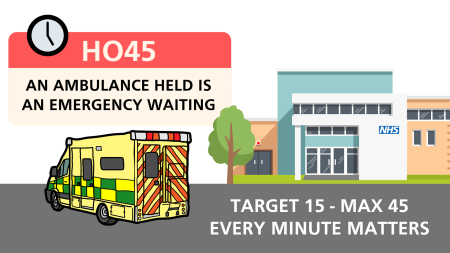What is Handover 45?
NHS England North West, North West Ambulance Service (NWAS), ICBs and Trusts are working together to improve ambulance response times.
From 1 August 2025, all ambulance handovers must be completed within 45 minutes.
This aligns with the NHS Operational Planning Guidance and Urgent and Emergency Care Plan 2025/26.
The underpinning handover standard has always been, and remains, 15 minutes, but we know that often 45 minutes is still exceeded in the North West – more than 10% of handovers still exceed 45 minutes.
Delayed handovers negatively impact patient outcomes and the availability of ambulance services. An ambulance held is an emergency waiting.
The HO45 protocol is designed to limit handover delays to a maximum of 45 minutes, with the goal of achieving 95% handovers within 15 minutes.
It is key to improving ambulance response times by getting crews back on the road to respond to emergencies and will help to reduce risk and improve patient outcomes.
All hospitals with Type 1 EDs must implement local escalation protocols to support HO45 - the 45-minute maximum handover time.
What do you need to know about HO45 and how does it impact you?
-
Handover 45 impacts all staff, not just those in ED.
-
Ambulances will be 'Released to Rescue' at a maximum of 45 minutes
-
Reducing ambulance handover times (to a maximum of 45 mins) means ambulances will be released back to the community, to assist other emergency patients.
-
Ensuring ED in reach colleagues (imaging, bloods etc) are seeing patients sooner to enable faster diagnostics to get patients admitted to the right speciality or seen in an alternative setting outside of hospital and closer to home, if appropriate.
-
Encouraging patients to keep mobile, maintain nutrition and hydration (if not Nil By Mouth NBM) during their wait to be seen can help prevent deconditioning.
-
By discharging Ready for Discharge patients, or patients with No Criteria to Reside patients from the wards, will ensure the acute hospital bed is occupied timely by those patients who require an admission.
-
Asking the patient about their personal capabilities and home circumstances on arrival can help establish baseline information, enabling care teams to understand more about a patient’s lifestyle prior to admission to hospital.
-
Early blood tests on the wards can enable quicker diagnostics to prescribe medications/treatment sooner.
-
Maintaining communication with families helps to plan a patient’s discharge.
-
Ensuring patients receive the correct patient information on discharge (meal plans, condition specific information, prescriptions etc) can enable a patient to be discharged sooner and maintain their recovery. This can also prevent a further admission.
-
Remember keeping patients in hospital longer than required, is lost hours away from home, and often the wrong place for their well being and recovery.
